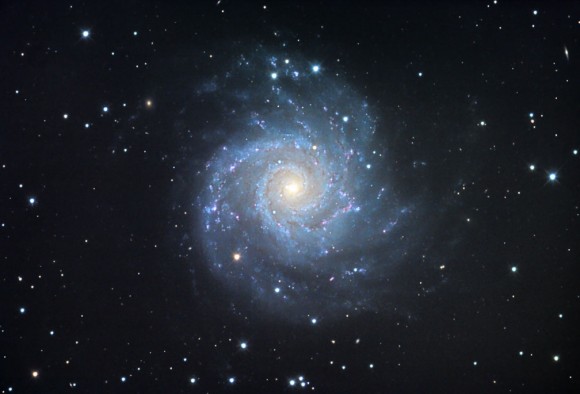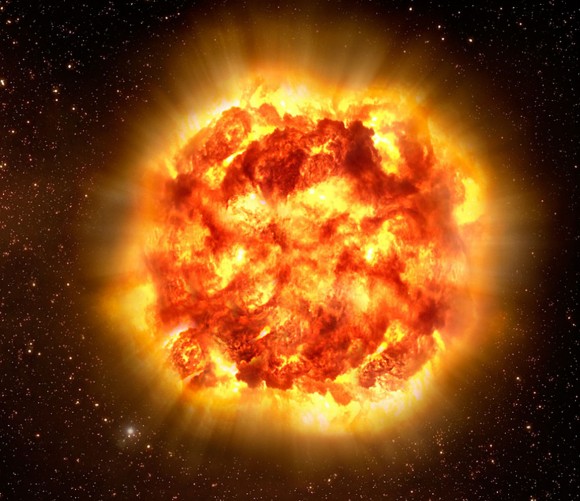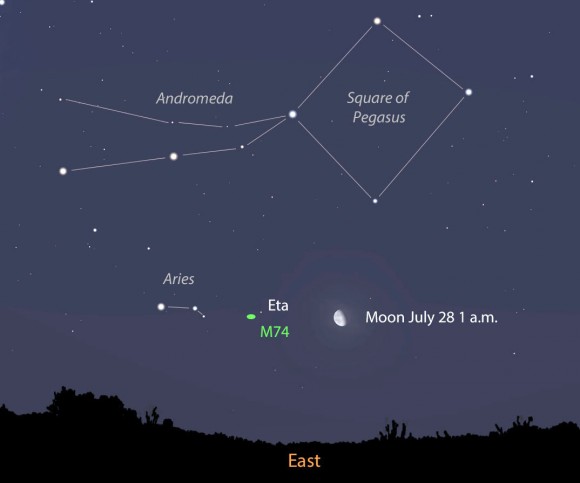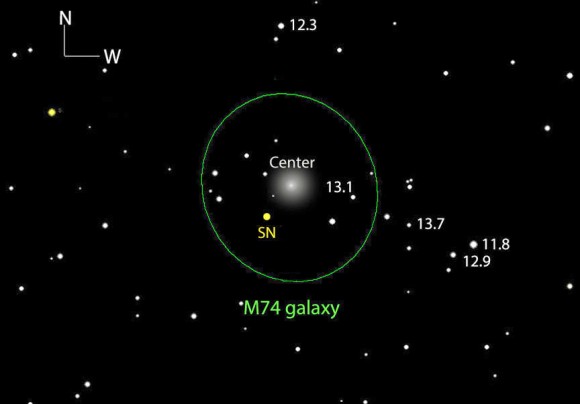Want to stay on top of all the space news? Follow @universetoday on Twitter

One of the first photos of the new supernova (at tick marks) in the nearby galaxy M74 taken by the Italian Supernova Search Project. The object is located 93? east and 135? south of the galaxy?s center. Click to learn more about the search group. Credit: Fabio Martinelli
I love this galaxy. Not only does M74 display a near perfect spiral form but if this latest supernova is the third to ?go boom? in the galaxy in just 11 years. The new object, designated PSN J01364816+1545310, was discovered blazing near 12.4 magnitude by the?Lick Observatory Supernova Search?at Lick Observatory near San Jose, Calif. ?PSN? stands for ?possible supernova? and the long string of numbers give the object?s position in the sky using the celestial equivalents of latitude and longitude.

M74 is a classic spiral galaxy with arms that appear to unwind from a bright, star-packed nucleus. Located 32 million light years away in the constellation Pisces, M74 contains about 100 billion stars. The spiral arms are dotted with dense star clusters and pink clouds of fluorescing hydrogen gas. Credit: Jim Misti
The Lick search uses a fully robotic or automated 30-inch (76 cm) telescope dedicated to scanning the skies for new supernovae. It nailed M74?s latest exploding star on July 25. Two previous supernovae flared in the galaxy -?SN 2002ap?and?SN 2003gd?- and rose to 12th and 13th magnitude respectively before fading away into obscurity.

Size comparison of our Milky Way spiral galaxy with M74. The Milky Way measures about 100,000 light years across; M74 about 30,000. Credit: NASA (left) and Jim Misti
Three?s the charm as they say. A team of astronomers using a spectrograph at the Faulkes Telescope South at Siding Spring, Australia teased apart the supernova?s light and now know exactly what blew up. It appears our newcomer was originally a supergiant star at least 8 times as massive as the sun.?After a relatively brief lifetime measured in the millions of years, the supergiant gobbled up the last of its fuel. With the gas gauge on ?empty? and no new energy being produced in the core to hold back ?the force of gravity, the star imploded, sending a shockwave rocketing back in the opposite direction that tore it to bits.

When a massive star runs out of nuclear fuel in its core, the energy that has prevented the force of gravity from crushing it is gone. Gravity finally gains the upper hand causing the star to implode. A rebounding shock wave blows it to bits. Sometime a city-sized, dense stellar remnant called a neutron star remains after the blast. Credit: ESO
Called a Type II supernova explosion, the blast hurtles star stuff into space at up to 45,000 miles per second (70,000 km/sec). More amazing, a powerful supernova explosion can release as much energy as the sun during its entire 10 billion year lifetime. No wonder even small telescopes can spot these cataclysmic events from millions of light years away!

The galaxy M74, the 74th entry in 18th century astronomer Charles Messier?s catalog, is found about 1.5 degrees east-northeast of the star Eta Piscium just to the right of the small constellation Aries the Ram. The map shows the sky around 1 a.m. tomorrow morning facing east. Stellarium
As additional photos and measurements come in, ?amateur astronomers with 8-inch and larger telescopes will have no problem spying the supernova once the last quarter moon departs the vicinity. It?s located 93? (1.5?) ?east and 135? (more than 2?) southeast of the galaxy?s core. The map and photo will help you track it down.

This map measures only about 1/2-degree wide and shows the galaxy up close with the supernova marked SN. Selected star magnitudes from the AAVSO are shown to help you navigate to the object as well as estimate its brightness. North is up, west to the right. Map created with Chris Marriott?s SkyMap software
While M74 is relatively bright and appears spectacular in long-exposure photos, it looks like a large, dim featureless glow in smaller telescopes. Be patient and take your time to ?star hop? to the supernova using the more detailed map. Matter of fact, you may want to wait until Tuesday morning or later to look. That?s when the waning moon will finally depart the area. Let?s hope our new guest remains bright.
Good luck meeting the latest star to mark the end of its life with the biggest blowout of all. For more information and photos, stop by Dave Bishop?s Latest Supernovae site.
* This article was updated at 6:30 pm CDT on 7/28/13
?
About Bob King
I'm a long-time amateur astronomer and member of the American Association of Variable Star Observers (AAVSO). My observing passions include comets, variable stars, deep sky, and photographing sky events like conjunctions and northern lights.
Columbine shooting Ryan Lanza Facebook Connecticut shooting Nancy Lanza school shootings Jenni Rivera Adam Lanza Facebook
No comments:
Post a Comment
Note: Only a member of this blog may post a comment.